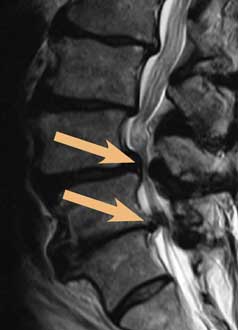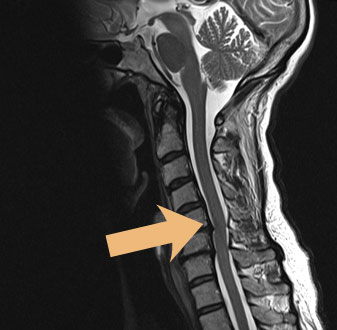Lumbar spinal canal stenosis is a narrowing of the lumbar spinal canal causing various symptoms and emerging more often in the old age. Due to the ‘pincer´s effect’, compression damage of nerve roots follows (see illustration A and B). Because the term spinal canal stenosis is often replaced by the more common term spinal stenosis, we use it in the following text. Most spinal canal stenoses are to be found in lumbar spine or cervical spine.
Spinal stenosis / spinal canal stenosis
Spinal stenosis lumbar spine / spinal canal stenosis lumbar spine
Symptoms spinal stenosis lumbar spine/ spinal canal stenosis lumbar spine
Spinal stenosis causes constant and severe pain in back and legs, cramps and, on a long-term basis, loss of sensation, paralysis and other neurological deficits. Here are the symptoms of spinal stenosis in an overview:
- back pain
- leg pain
- cramps
- sensation loss
- paralysis and other neurological deficits
Causes spinal stenosis lumbar spine/ spinal canal stenosis lumbar spine
A thickening of bones and posterior ligaments causes spinal stenosis. The spinal canal becomes narrowed and the nerves in the spinal canal are compressed. Spinal stenosis is concentrated in severely strained regions of the spine and does not spread over the whole spinal canal. Pressure damage of the nerve roots is a result of spinal stenosis, entailing several symptoms.
Diagnostics spinal stenosis lumbar spine/ spinal canal stenosis lumbar spine
To differentiate spinal stenosis from other spinal diseases causing similar complaints, patients first get a neurological-orthopedic examination including a comprehensive talk about the history and treatment of illness. Often imaging examinations like MRI follow. Magnet resonance imaging enables us to examine and visualize a spinal stenosis and other spinal diseases very thoroughly. The image on the lef shows a high-grade spinal stenosis with nerve root compression in two levels. At Beta Klinik we use an open MRI system which allows us to comfortly examine patients suffering from claustrophobia or patients up to 250 kg (500 lbs).
Treatment spinal stenosis lumbar spine / spinal canal stenosis lumbar spine
Spinal stenosis in lumbar spine can be treated by two kinds of surgery, spacer surgery or microscopic decompression surgery (microlaminectomy). Which of the two procedures is recommended depends on various factors and has to be weighed up carefully.
In case of moderate spinal stenosis, the least straining treatment – especially for patients with contraindication for general anaesthesia – is the spacer surgery by placing the metal spacer between the spinous processes in height of the spinal stenosis. This dilatates the diameter of the spinal canal through raising and can eliminate the spinal stenosis.
In case of decompression surgery (microlaminectomy), the thickened and protruding bone and ligament formations are removed by employing a microscope and microscopic fraises. Thus, the nomal diameter of the spinal canal is reconstructed. The surgical procedures for the cure of spinal stenosis in short:
- stabilization by virtue of spacer surgery
- microscopic decompression (microlaminectomy)
Spinal stenosis cervical spine / spinal canal stenosis cervical spine
Symptoms spinal stenosis cervical spine / spinal canal stenosis cervical spine
Spinal canal stenosis can cause shoulder-arm pain up to paralysis and decrease of sensation. The compression can also result in paralysis and decrease of sensation of the legs. In worst case, a paraplegia is the result of spinal canal stenosis. This can also be the case by virtue of a downfall combined with a spinal hyperextension. The symptoms of spincal canal stenosis in an overview:
Causes spinal stenosis cervical spine / spinal canal stenosis cervical spine
Spinal canal stenosis, like most of degenerative diseases of spine, increases in old age. A thickening of bones and posterior ligaments causes stenosis. The spinal canal becomes narrowed and the nerves in the spinal canal are compressed. Such a stenosis is concentrated in heavily afflicted regions of the spine and does not spread over the whole spinal canal. Pressure damage of the nerve roots follows, which can entail several complaints.
Diagnostics spinal stenosis cervical spine / spinal canal stenosis cervical spine
To differentiate spinal canal stenosis from other spinal diseases causing similar complaints, patients first get a neurological-orthopedic examination including a comprehensive talk about the history and treatment of illness. Often imaging examinations like MRI follow. Magnet resonance imaging enables us to examine and visualize a spinal stenosis and other spinal diseases very thoroughly. The MR image on the right depicts a spinal stenosis in cervical spine in several segments compressing the spinal canal.
At Beta Klinik we use an open MRI system which allows us to comfortly examine patients suffering from claustrophobia or patients up to 250 kg (500 lbs).
Treatment of spinal stenosis cervical spine / spinal canal stenosis cervical spine
Because paraplegia is to be the worst case scenario of cervical spinal canal stenosis in combination with a downfall and a hyperextension of cervical spine, it is treated preventively with surgery, also if there are no clinical symptoms. Which kind of surgery is performed, depends on different aspects and has to be weighed up thoroughly.
In case of the so-called decompression surgery (microlaminectomy), the thickened and protruding bone and ligament formations are removed by employing a microscope and microscopic fraises. Thus, the nomal diameter of the spinal canal is reconstructed.
Before treating cervical spinal canal stenosis with stabilization (fusion, stiffening or spondylodesis), the individual usage and chances of success of all other procedures should be taken into consideration. During stabilization neurosurgeons combine bone tissue, plates, so-called cages and screws to permanently stabilize the spine.
The therapeutical options for treating spincal canal stenosis in cervical spine in short:
- decompression surgery (microlaminectomy): frontal or dorsal dilatation of the spinal canal, if necessary implantation of stabilizing elements like cage, artificial disc / disc prosthesis or a vertebral body replacement systems
- stabilization (fusion, stiffening or spondylodesis) wih a rod-screw system





